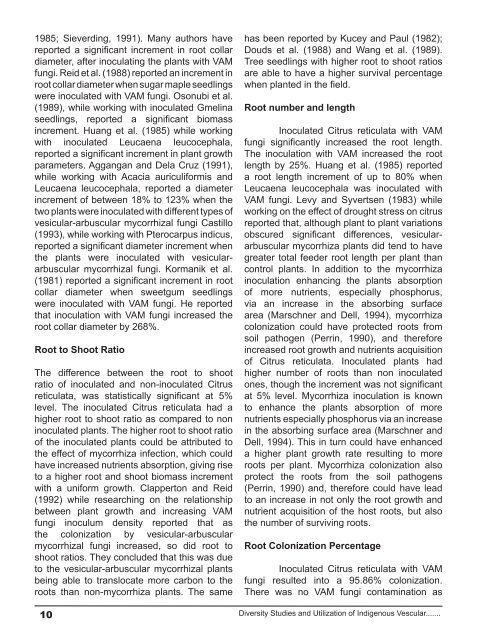download the full article here - EISRJC
download the full article here - EISRJC
download the full article here - EISRJC
You also want an ePaper? Increase the reach of your titles
YUMPU automatically turns print PDFs into web optimized ePapers that Google loves.
1985; Sieverding, 1991). Many authors have<br />
reported a significant increment in root collar<br />
diameter, after inoculating <strong>the</strong> plants with VAM<br />
fungi. Reid et al. (1988) reported an increment in<br />
root collar diameter when sugar maple seedlings<br />
were inoculated with VAM fungi. Osonubi et al.<br />
(1989), while working with inoculated Gmelina<br />
seedlings, reported a significant biomass<br />
increment. Huang et al. (1985) while working<br />
with inoculated Leucaena leucocephala,<br />
reported a significant increment in plant growth<br />
parameters. Aggangan and Dela Cruz (1991),<br />
while working with Acacia auriculiformis and<br />
Leucaena leucocephala, reported a diameter<br />
increment of between 18% to 123% when <strong>the</strong><br />
two plants were inoculated with different types of<br />
vesicular-arbuscular mycorrhizal fungi Castillo<br />
(1993), while working with Pterocarpus indicus,<br />
reported a significant diameter increment when<br />
<strong>the</strong> plants were inoculated with vesiculararbuscular<br />
mycorrhizal fungi. Kormanik et al.<br />
(1981) reported a significant increment in root<br />
collar diameter when sweetgum seedlings<br />
were inoculated with VAM fungi. He reported<br />
that inoculation with VAM fungi increased <strong>the</strong><br />
root collar diameter by 268%.<br />
Root to Shoot Ratio<br />
The difference between <strong>the</strong> root to shoot<br />
ratio of inoculated and non-inoculated Citrus<br />
reticulata, was statistically significant at 5%<br />
level. The inoculated Citrus reticulata had a<br />
higher root to shoot ratio as compared to non<br />
inoculated plants. The higher root to shoot ratio<br />
of <strong>the</strong> inoculated plants could be attributed to<br />
<strong>the</strong> effect of mycorrhiza infection, which could<br />
have increased nutrients absorption, giving rise<br />
to a higher root and shoot biomass increment<br />
with a uniform growth. Clapperton and Reid<br />
(1992) while researching on <strong>the</strong> relationship<br />
between plant growth and increasing VAM<br />
fungi inoculum density reported that as<br />
<strong>the</strong> colonization by vesicular-arbuscular<br />
mycorrhizal fungi increased, so did root to<br />
shoot ratios. They concluded that this was due<br />
to <strong>the</strong> vesicular-arbuscular mycorrhizal plants<br />
being able to translocate more carbon to <strong>the</strong><br />
roots than non-mycorrhiza plants. The same<br />
has been reported by Kucey and Paul (1982);<br />
Douds et al. (1988) and Wang et al. (1989).<br />
Tree seedlings with higher root to shoot ratios<br />
are able to have a higher survival percentage<br />
when planted in <strong>the</strong> field.<br />
Root number and length<br />
Inoculated Citrus reticulata with VAM<br />
fungi significantly increased <strong>the</strong> root length.<br />
The inoculation with VAM increased <strong>the</strong> root<br />
length by 25%. Huang et al. (1985) reported<br />
a root length increment of up to 80% when<br />
Leucaena leucocephala was inoculated with<br />
VAM fungi. Levy and Syvertsen (1983) while<br />
working on <strong>the</strong> effect of drought stress on citrus<br />
reported that, although plant to plant variations<br />
obscured significant differences, vesiculararbuscular<br />
mycorrhiza plants did tend to have<br />
greater total feeder root length per plant than<br />
control plants. In addition to <strong>the</strong> mycorrhiza<br />
inoculation enhancing <strong>the</strong> plants absorption<br />
of more nutrients, especially phosphorus,<br />
via an increase in <strong>the</strong> absorbing surface<br />
area (Marschner and Dell, 1994), mycorrhiza<br />
colonization could have protected roots from<br />
soil pathogen (Perrin, 1990), and <strong>the</strong>refore<br />
increased root growth and nutrients acquisition<br />
of Citrus reticulata. Inoculated plants had<br />
higher number of roots than non inoculated<br />
ones, though <strong>the</strong> increment was not significant<br />
at 5% level. Mycorrhiza inoculation is known<br />
to enhance <strong>the</strong> plants absorption of more<br />
nutrients especially phosphorus via an increase<br />
in <strong>the</strong> absorbing surface area (Marschner and<br />
Dell, 1994). This in turn could have enhanced<br />
a higher plant growth rate resulting to more<br />
roots per plant. Mycorrhiza colonization also<br />
protect <strong>the</strong> roots from <strong>the</strong> soil pathogens<br />
(Perrin, 1990) and, <strong>the</strong>refore could have lead<br />
to an increase in not only <strong>the</strong> root growth and<br />
nutrient acquisition of <strong>the</strong> host roots, but also<br />
<strong>the</strong> number of surviving roots.<br />
Root Colonization Percentage<br />
Inoculated Citrus reticulata with VAM<br />
fungi resulted into a 95.86% colonization.<br />
T<strong>here</strong> was no VAM fungi contamination as<br />
10 Diversity Studies and Utilization of Indigenous Vescular.......

















